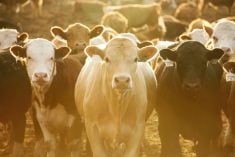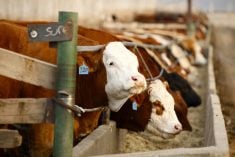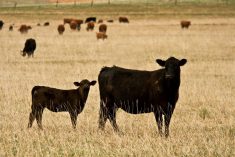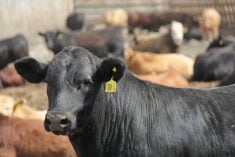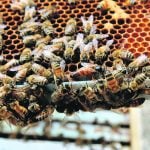Western Canadian feeder cattle prices were quite variable this past week. Strength was noted in the eastern Prairie regions where markets traded $5 to as much as $10 above week-ago levels; however, Alberta steer prices were relatively unchanged but heifers traded $5 to $8 higher.
Available feeder supplies will tighten as we approach the end of the year, which has caused the steer-heifer spread to narrow. Feedlot operators shrugged off weakness in the deferred live cattle futures. Alberta packers were buying fed cattle from $148 to $150 and improving margins in the nearby positions enhanced buying interest. Consumer confidence has reached record highs so it appears consumer spending will remain strong into the New Year. A US$20/cwt rally in wholesale choice beef prices from September’s lows has spilled over into the feeder market.
Read Also

U.S. grains: Soy futures post biggest monthly gain in nearly five years on China trade optimism
U.S. soybean futures climbed to a 15-month high and posted their biggest monthly gain in nearly five years on Friday following a rally fueled by the prospect of revived exports to China.
We’re seeing fleshier cattle come on stream, but the market continues to percolate higher. Simmental-cross medium-frame steers with higher flesh levels, weighing 945 lbs., were quoted at $193 in southern Alberta; medium-frame tan heifers averaging 910 lbs. sold for $193. There was noticeable gain in heifer prices and the steer premium was negligible in the heavier weight categories.
Western Canada was divided into two distinct markets this past week. Lofty levels were reached in eastern Saskatchewan, with Ontario orders leading the charge higher. Mixed steers weighing just over 600 lbs. were quoted at $252 in southeastern Saskatchewan, which reflected a $15 premium over average Alberta prices. In southern British Columbia, the Canadian satellite recap had a larger group of Charolais-cross 500-lb. calves trading for $266; heifers weighing 465 lbs. reportedly sold for $229.
The buildup of equity in the feedlot sector over the past year is the main factor driving nearby feeder prices. Cattle sold this week don’t pencil out, but this is having a limited effect on the market. We’re now into the homestretch of the year and with declining supplies, we’re looking for steady to higher prices over the next couple of weeks.
— Jerry Klassen manages the Canadian office of Swiss-based grain trader GAP SA Grains and Produits Ltd. and is president and founder of Resilient Capital, specializing in proprietary commodity futures trading and market analysis. Jerry consults with feedlots on risk management and writes a weekly cattle market commentary. He can be reached at 204-504-8339.




